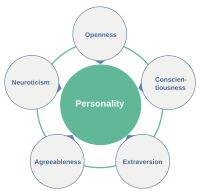
Photo from wikipedia
Ecologists use a functional trait-based approach to seek a general understanding of organism—environment interactions, but, among primary producers, the empirical basis rests on vascular plants. We hypothesised that with increasing… Click to show full abstract
Ecologists use a functional trait-based approach to seek a general understanding of organism—environment interactions, but, among primary producers, the empirical basis rests on vascular plants. We hypothesised that with increasing intertidal elevation, traits of large brown macroalgae would reflect a resource acquisition vs. conservation (stress tolerance) trade-off at species and community levels. Across the elevation gradient at four UK sites of varying wave exposure, we: (1) screened species’ relevant morphological traits, using principal component analysis to reduce dimensionality; and (2) up-scaled species’ traits using community weighted trait means (CWMs). The first principal component (PC1) strongly related to specific thallus area and thallus dry matter content, representing an acquisition–conservation trade-off. Although species generally shifted to the conservative end of this axis as elevation increased, mid-shore Ascophyllum nodosum sat at the extreme conservative end. PC2 related to holdfast ratio, thickness and length, with A. nodosum scoring higher than other mid-shore species. CWMs of PC1 decreased with elevation at two sites indicating a shift from ‘fast’ to ‘slow’ ecosystem functioning, but this relationship was disrupted by A. nodosum at the sheltered site, and by the up-shore extent of Laminaria digitata at the most exposed site. The anomalous traits of A. nodosum reflect its unique competitive strategy (slow, persistent growth) in the relatively stressful mid-shore. Seaweed functional traits show promise in linking species’ identities to their strategies and ecosystem contributions. However, because resource conservation traits can be related to competitive as well as stress-tolerance strategies, predicting seaweed trait responses to environmental stress gradients is challenging.
Journal Title: Marine Biology
Year Published: 2019
Link to full text (if available)
Share on Social Media: Sign Up to like & get
recommendations!